
Internet Explorer
Customizing Internet Explorer
Customizing Internet Explorer
If you want your browser to feel a bit more personal, it's easy to customize Internet Explorer. In this lesson, we'll talk about different ways you can modify Internet Explorer, including startup options and add-ons, which allow you to add new functions to the browser.
Choosing your startup options
To choose a homepage:
By default, Internet Explorer will show www.msn.com whenever you start the browser. If you want to see a specific website every time you open your browser (like a news site or weather forecast), you can set that site as your homepage.
- Click the Tools button in the top-right corner of the browser, then select Internet options.
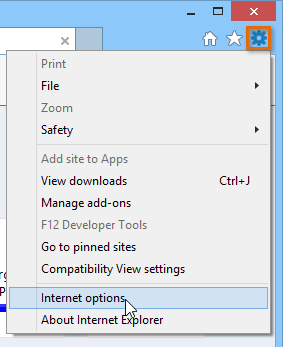 Selecting Internet options
Selecting Internet options - The Internet Options dialog box will appear. Under Home page, delete the default link and type the URL for the desired home page, then click OK.
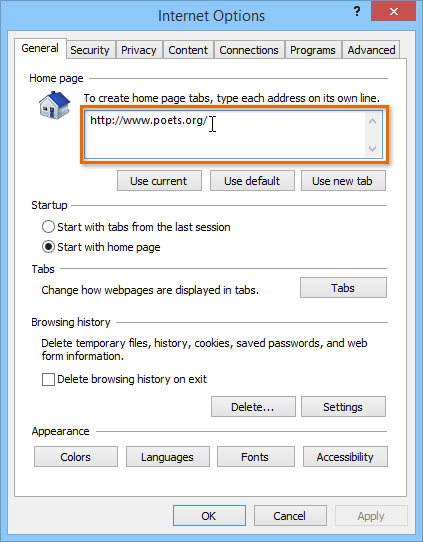 Choosing a new home page
Choosing a new home page - Your homepage will appear whenever you start Internet Explorer. Click the Home button to visit your homepage at any time.
 Clicking the Home button
Clicking the Home button
If there are certain pages you use every time you open your browser, like your email or calendar, you might consider making them all homepages. Each homepage will open in its own tab whenever you start Internet Explorer. Just enter the URL of each desired homepage on a new line in the Home page text box, then click OK.
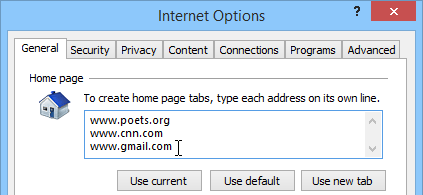 Setting multiple home pages
Setting multiple home pagesTo set Internet Explorer as the default browser:
Internet Explorer is the default browser on Windows computers. If you click a link in another program on your computer, like an email client, it will open in Internet Explorer. If you've set another web browser as the default, you can choose to switch back to Internet Explorer.
- Click the Tools button in the top-right corner of the browser, then select Internet Options.
- The Internet Options dialog box will appear. Select the Programs tab.
 Selecting the Programs tab
Selecting the Programs tab - Locate and select Make Internet Explorer the default browser, then click OK. Any link you open on your computer will now open in Internet Explorer.
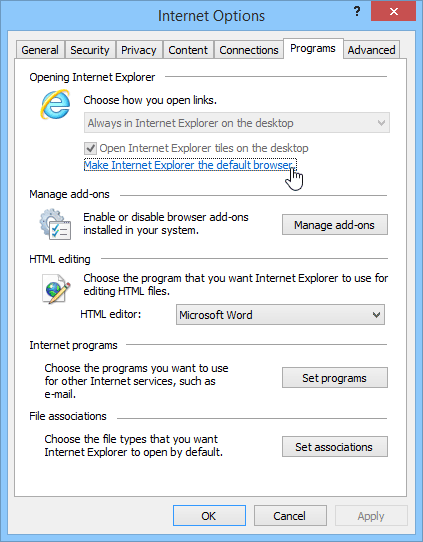 Setting Internet Explorer as the default browser
Setting Internet Explorer as the default browser
Internet Explorer add-ons
Add-ons add different functionality to Internet Explorer. For example, add-ons can add new search engines to the address bar, block ads, and keep you updated on current events.
To install an add-on:
- Click the drop-down menu in the address bar, then select the Add button in the bottom-right of the menu.
 Selecting the Add button
Selecting the Add button - The Internet Explorer Gallery will appear. Click search providers on the left, then select the type of add-on you're looking for.
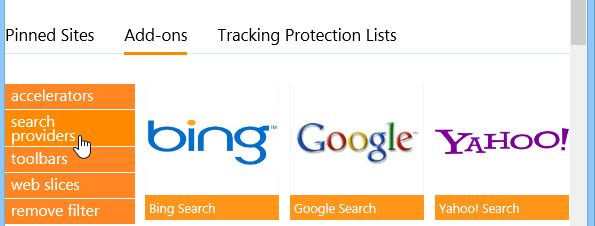 Selecting an add-on type
Selecting an add-on type - Select an add-on to learn more about it.
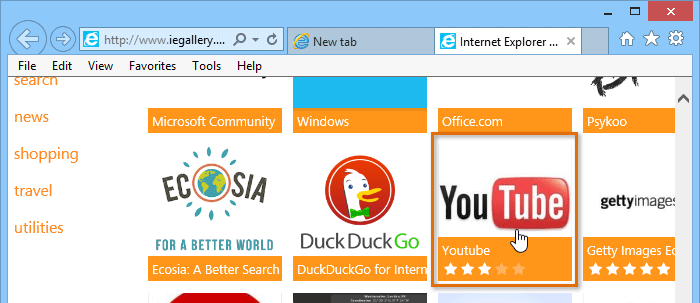 Selecting an add-on
Selecting an add-on - You'll be taken to a page with more information about the add-on. If you want to install it, click Add to Internet Explorer.
 Installing an add-on
Installing an add-on
It's important to note that add-ons are not necessarily created or approved by Microsoft. Many are created by third-party providers or even individual users, so they may not always be safe to install. We recommend that you read user reviews carefully before installing an add-on.
Accelerators and web slices
Accelerators and web slices are types of add-ons available for Internet Explorer. Accelerators allow you to translate, search for, or map text you've selected in the browser. Web slices give you real-time updates for specific websites in your Favorites bar. For example, you could use a web slice to get quick updates on sports scores or the weather forecast.
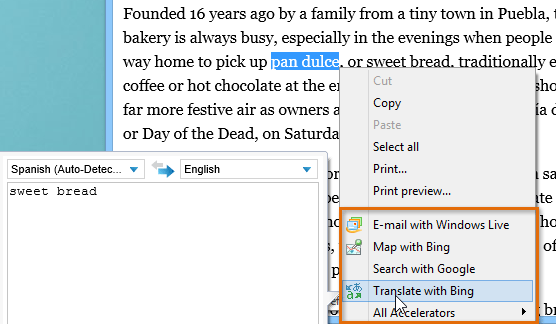 Using an Accelerator
Using an AcceleratorIn our experience, web slices don't work consistently and aren't available for many websites, so their usefulness may be limited.
To manage add-ons:
If you don't like an add-on, the Manage Add-ons feature allows you to disable or remove it from Internet Explorer.
- Click the Tools button in the top-right corner of the browser, then select Manage add-ons.
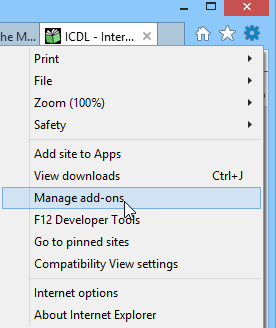 Selecting Manage add-ons
Selecting Manage add-ons - The Manage Add-ons dialog box will appear.
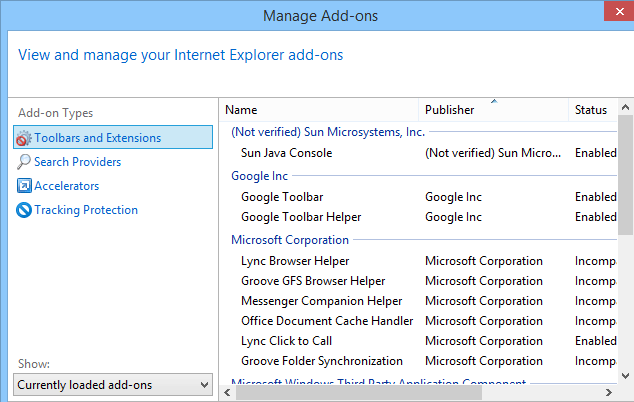 The Manage Add-ons dialog box
The Manage Add-ons dialog box - Select the type of add-on you want to manage on the left. A list of installed add-ons of that type will appear. From here, they can be temporarily disabled or removed.
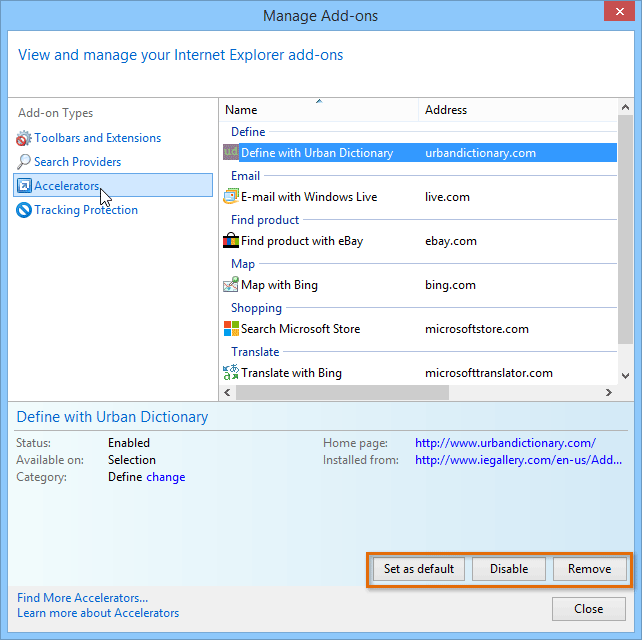 Selecting an add-on type
Selecting an add-on type